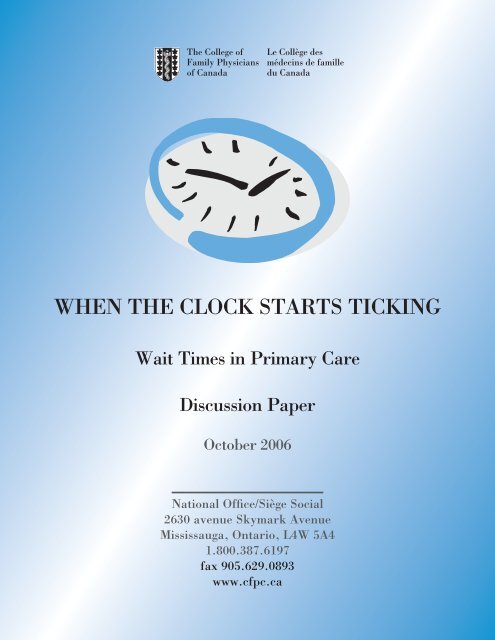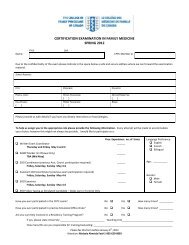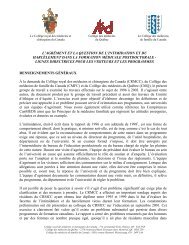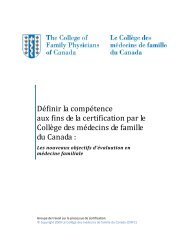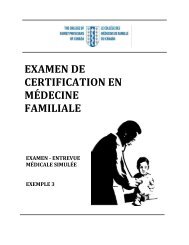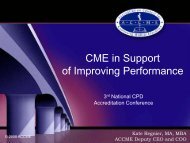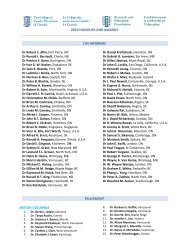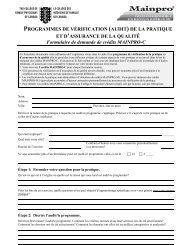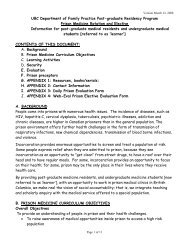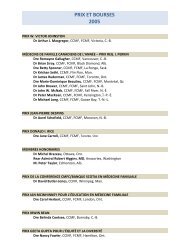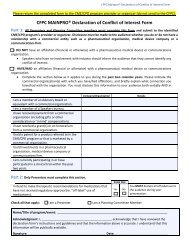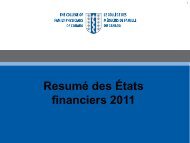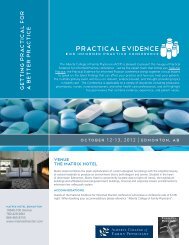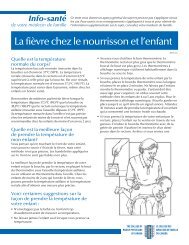When The Clock Starts Ticking: Wait Times in Primary Care
When The Clock Starts Ticking: Wait Times in Primary Care
When The Clock Starts Ticking: Wait Times in Primary Care
Create successful ePaper yourself
Turn your PDF publications into a flip-book with our unique Google optimized e-Paper software.
WHEN THE CLOCK STARTS TICKING<strong>Wait</strong> <strong>Times</strong> <strong>in</strong> <strong>Primary</strong> <strong>Care</strong>Discussion PaperOctober 2006National Office/Siège Social2630 avenue Skymark AvenueMississauga, Ontario, L4W 5A41.800.387.6197fax 905.629.0893www.cfpc.ca<strong>Wait</strong>_times_Oct06.<strong>in</strong>dd 110/6/06 3:06:36 PM
<strong>The</strong> College of Family Physicians of Canada (CFPC) strives toimprove the health of Canadians by:• Ensur<strong>in</strong>g the highest standards of tra<strong>in</strong><strong>in</strong>g, certification, andma<strong>in</strong>tenance of proficiency for family physicians;• Educat<strong>in</strong>g and <strong>in</strong>form<strong>in</strong>g the public about healthful liv<strong>in</strong>g;• Support<strong>in</strong>g research and dissem<strong>in</strong>at<strong>in</strong>g knowledge; and• Champion<strong>in</strong>g the rights of every Canadian to high-qualityhealth care.Represent<strong>in</strong>g 17,800 family doctors across the country, theCFPC is the collective voice of family medic<strong>in</strong>e <strong>in</strong> Canada.Its members are committed to the Four Pr<strong>in</strong>ciples of FamilyMedic<strong>in</strong>e:• <strong>The</strong> patient-doctor relationship is central to all we do.• Family physicians must be skilled cl<strong>in</strong>icians.• Family physicians should be a resource to a patientpopulation.• Family medic<strong>in</strong>e is a community-based discipl<strong>in</strong>e.<strong>Wait</strong>_times_Oct06.<strong>in</strong>dd 210/6/06 3:06:36 PM
Table of ContentsIntroduction ............................................................................................... pg 2Away from Home – International Experiences ........................................ pg 4Close to Home – Canadian Experiences ................................................... pg 7<strong>When</strong> the <strong>Clock</strong> <strong>Starts</strong> <strong>Tick<strong>in</strong>g</strong>:Challenges <strong>in</strong> Measur<strong>in</strong>g <strong>Wait</strong> <strong>Times</strong> <strong>in</strong> <strong>Primary</strong> <strong>Care</strong> .......................... pg 11Exam<strong>in</strong><strong>in</strong>g <strong>Wait</strong> <strong>Times</strong> <strong>in</strong> <strong>Primary</strong> <strong>Care</strong> More Closely ......................... pg 14Start<strong>in</strong>g to Build <strong>Wait</strong> Time Benchmarks <strong>in</strong> <strong>Primary</strong> <strong>Care</strong> .................... pg 16Achiev<strong>in</strong>g <strong>Wait</strong> Time Benchmarks <strong>in</strong> <strong>Primary</strong> <strong>Care</strong> .............................. pg 19Conclud<strong>in</strong>g Remarks ............................................................................... pg 21Appendix: ................................................................................................ pg 22
For all enquiries regard<strong>in</strong>g this document, please contact:Mr. Eric MangHealth Policy Manager<strong>The</strong> College of Family Physicians of Canada2630 Skymark Ave.,Mississauga, ON L4W 5A4Tel.: (905) 629-0900 ext.325; Fax: (905) 629-0893; E-mail: emang@cfpc.caMs Jocelyne CahillAdm<strong>in</strong>istrative Assistant – Health Policy<strong>The</strong> College of Family Physicians of Canada2630 Skymark Ave.,Mississauga, ON L4W 5A4Tel.: (905) 629-0900 ext.207; Fax: (905) 629-0893; E-mail: jcahill@cfpc.caThis document is available <strong>in</strong> full text <strong>in</strong> both official languages on the CFPC website at:www.cfpc.ca1
<strong>When</strong> the <strong>Clock</strong> <strong>Starts</strong> <strong>Tick<strong>in</strong>g</strong><strong>Wait</strong> <strong>Times</strong> <strong>in</strong> <strong>Primary</strong> <strong>Care</strong>- Discussion Paper -IntroductionFor many years <strong>The</strong> College of Family Physicians of Canada (CFPC) has advocated onbehalf of Canadians for appropriate and timely access to all aspects of health care throughtheir family physicians. <strong>The</strong> College’s positions have taken <strong>in</strong>to account the needs ofCanadians as patients wait<strong>in</strong>g <strong>in</strong> l<strong>in</strong>e to receive services throughout the cont<strong>in</strong>uum oftheir health care. This <strong>in</strong>cludes not just the wait time between the first visit with aconsult<strong>in</strong>g specialist and the patient’s def<strong>in</strong>itive procedure, surgery or treatment – butalso the time between the patient’s first visit with his/her family physician and whenrequired, a subsequent visit with a consultant. It also <strong>in</strong>cludes the time it takes for aCanadian who does not have a family physician to f<strong>in</strong>d one.While most research on wait times has addressed the time between the visit with theconsult<strong>in</strong>g specialist and the completion of a procedure or treatment, very little hasaddressed the time from the patient’s first <strong>in</strong>teraction with the primary care system, i.e.the first visit with a family physician for a particular problem through to more specializedcare with a consult<strong>in</strong>g specialist if required. This is a critical time period when thepatient and family physician together wait for more specialized advice, <strong>in</strong>vestigation ortreatment. It is a time <strong>in</strong>terval that must be <strong>in</strong>cluded <strong>in</strong> the determ<strong>in</strong>ation of acceptableand safe wait times for patientsWith few exceptions, evidence-based research on wait times between visits with familyphysicians to consultation with other medical specialists is seriously lack<strong>in</strong>g. Whilereports such as those from the <strong>Wait</strong> Time Alliance and Canadian Psychiatric Associationoffer hope, as do a few other <strong>in</strong>ternational experiences, much more work rema<strong>in</strong>s to bedone if we are to understand the issues that concern Canadians and wait times <strong>in</strong> primarycare.In exam<strong>in</strong><strong>in</strong>g this issue, it is apparent that measur<strong>in</strong>g wait times <strong>in</strong> the primary careenvironment is exceed<strong>in</strong>gly complex and requires an appreciation of many different<strong>in</strong>teractions between the primary care system <strong>in</strong> which family physicians serve theirpatients and more highly specialized care <strong>in</strong> other parts of the health system. For mostpatients, wait times for more highly specialized services occur while they are under thecare of their family physician or as an important part of shared care between their familyphysician and other consult<strong>in</strong>g specialists.2
Challenges <strong>in</strong> <strong>Primary</strong> <strong>Care</strong> <strong>Wait</strong> Time Measurement<strong>When</strong> start<strong>in</strong>g to build wait time benchmarks <strong>in</strong> primary care, there are a number ofchallenges that contribute to the complexity of this task. <strong>The</strong>se <strong>in</strong>clude:1) Number of Canadians without a family physician to help them access health care, theresult of physician shortages.2) Lack of evidence-based studies for wait times <strong>in</strong> primary care.3) Focus to date on data and <strong>in</strong>formation that are ma<strong>in</strong>ly related to the federalgovernment’s five def<strong>in</strong>ed areas for wait time management.4) Consideration given to ma<strong>in</strong>ly highly specialized services for wait time measurement.5) Difficulty <strong>in</strong> understand<strong>in</strong>g the most appropriate wait times for undifferentiatedconditions seen <strong>in</strong> primary care.6) Need to develop cl<strong>in</strong>ical guidel<strong>in</strong>es to def<strong>in</strong>e the diagnostic criteria that must be metfor a patient <strong>in</strong> primary care to be registered on a wait list that guarantees treatmentwith<strong>in</strong> a def<strong>in</strong>ed period of time.7) Concerns of health care professionals, <strong>in</strong>clud<strong>in</strong>g family physicians, regard<strong>in</strong>g theresponsibility to meet wait time benchmarks, with the potential to <strong>in</strong>crease tensionthat already exists <strong>in</strong> the health system, particularly <strong>in</strong> the face of physician shortages.8) Potential to <strong>in</strong>crease other political and f<strong>in</strong>ancial tensions that will face governmentsand health authorities as accountability for health system resources are def<strong>in</strong>ed to tryto meet much longer lists of primary care wait time benchmarks.3
Away from Home – International ExperiencesInternationally, there is <strong>in</strong>creas<strong>in</strong>g experience manag<strong>in</strong>g wait times <strong>in</strong> primary care. <strong>The</strong>conclusion that can be drawn from review<strong>in</strong>g the literature however is that there are manydifferent ways of approach<strong>in</strong>g this challenge and the need rema<strong>in</strong>s for more research todeterm<strong>in</strong>e how best to measure and manage wait times <strong>in</strong> primary care.In attempt<strong>in</strong>g to reduce wait times for those access<strong>in</strong>g health care <strong>in</strong> England, theNational Health Service (NHS) focused on ensur<strong>in</strong>g that 99% of its citizens have accessto a general practitioner. 1 In fact, <strong>in</strong> 2004, the standard for wait time benchmarks set bythe NHS was that patients should be able to see a primary health care professional with<strong>in</strong>24 hours and a general practitioner (family physician) with<strong>in</strong> 48 hours. 2Canada’s primary care system does not fare well when compar<strong>in</strong>g patient access to samedayappo<strong>in</strong>tments between five similar countries. (See Figure I.) In 2004 Canada wasidentified as the country with the lowest percentage of citizens who could access aphysician with a same-day appo<strong>in</strong>tment (27%), compared to the United States (33%), theUnited K<strong>in</strong>gdom (41%), Australia (54%) or New Zealand (60%). Likewise, barriers toaccess<strong>in</strong>g primary care resulted <strong>in</strong> the highest percentage of patients (25%) wait<strong>in</strong>g 6days or more to visit a physician <strong>in</strong> Canada when compared to the same five countries:the United States (19%), the United K<strong>in</strong>gdom (13%), Australia (7%) and New Zealand(2%). <strong>When</strong> the Commonwealth Fund extended this study <strong>in</strong> 2005 to <strong>in</strong>clude Germanyand exam<strong>in</strong>ed primary care wait times of four weeks or more to see a “specialist”,Canada came <strong>in</strong> second lowest with 57% of its citizens wait<strong>in</strong>g at least this long to accessspecialty care, compared to the United States at 60%. By comparison, Australia wasbetter at 46%, the United K<strong>in</strong>gdom at 40%, Germany at 23% and New Zealand at 22%.Consider<strong>in</strong>g that Canada ranks only 26 th out of 30 OECD countries <strong>in</strong> its supply ofphysicians to serve the population, 3 and that a greater supply of primary care physiciansis strongly related to improved health outcomes, 4 there is good reason to believe thatproblems <strong>in</strong> access to care (as identified above) and the quality of care could besignificantly improved by f<strong>in</strong>d<strong>in</strong>g solutions to <strong>in</strong>crease the number of family physicians<strong>in</strong> Canada. <strong>The</strong>se are challenges that federal, prov<strong>in</strong>cial and territorial governments mustcont<strong>in</strong>ue to address <strong>in</strong> consultation with appropriate stakeholders, <strong>in</strong>clud<strong>in</strong>g the CFPC.1 Presentation by Dr. David Col<strong>in</strong>-Thomé: Global Perspectives on <strong>Primary</strong> <strong>Care</strong> - Accelerat<strong>in</strong>g <strong>Primary</strong><strong>Care</strong> Conference, February 15, 2006, Edmonton, Alberta, Canada.2 Peter Bower, Mart<strong>in</strong> Rowland, John Campbell, Nicola Mead, Sett<strong>in</strong>g standards based on patients’ viewson access and cont<strong>in</strong>uity: secondary analysis of data from the general practice assessment survey, BritishMedical Journal, 2003 Feb; 326; 258.3 Organization for Economic Cooperation and Development [OECD] (2004), OECD Health Data 2004: AComparative Analysis of 30 Countries, 3rd ed. CD-ROM. Paris.4 Starfield, Barbara, Leiyu Shi, Atul Grover, James Mac<strong>in</strong>ko, <strong>The</strong> Effects of Specialist Supply onPopulations’ Health: Assess<strong>in</strong>g the Evidence, Health Affairs, Web exclusive, March 15, 2005.4
Figure I: Percent (%) of Population Access<strong>in</strong>g a Physician with<strong>in</strong>Def<strong>in</strong>ed <strong>Wait</strong> <strong>Times</strong> In Six Developed CountriesAustralia Canada NewZealandUnitedK<strong>in</strong>gdomUnitedStatesGermanySame DayAppo<strong>in</strong>tment toSee Physician<strong>Wait</strong> of 6 Days orMore to SeePhysician<strong>Wait</strong> of MoreThan 4 Weeks toSee a Specialist54 27 60 41 337 25 2 13 1946 57 22 40 60 23Sources of Information:1) Commonwealth Fund 2004, <strong>Primary</strong> <strong>Care</strong> and Health System Performance: Adults’ Experiences<strong>in</strong> Five Countries (access to physician when sick or need medical attention on same day or afterwait of six days or more)2) Commonwealth Fund 2005, 2005 International Health Policy Survey (access to specialist aftermore than four weeks)________________________________________________________________________Sweden and Norway have each taken unique approaches to manag<strong>in</strong>g primary care waittimes. <strong>The</strong>ir experiences were presented at an Ottawa conference <strong>in</strong> March 2006: Tam<strong>in</strong>gof the Queue III. Sweden guarantees same-day access to a primary care centre (notnecessarily to a physician) and access to a physician with<strong>in</strong> seven days. Sweden’s waittime guarantee also <strong>in</strong>cludes a 90-day maximum to see a specialist with another 90-daymaximum follow<strong>in</strong>g the specialist visit for start<strong>in</strong>g specialty treatment. (See Figure II.)This l<strong>in</strong>ear approach to establish<strong>in</strong>g wait time guarantees could stimulate further th<strong>in</strong>k<strong>in</strong>gabout how Canadians address the challenges of primary care wait times <strong>in</strong> this country.________________________________________________________________________Figure II: Sweden’s <strong>Wait</strong> Time Guarantee079090Guaranteed accessto local primarycare centre samedayAccess to see aphysician with<strong>in</strong>seven daysMaximum n<strong>in</strong>etydays to see aspecialistTreatment startedmaximum n<strong>in</strong>etydays from see<strong>in</strong>g aspecialist5
What appears to have worked best to date <strong>in</strong> Norway has been the <strong>in</strong>troduction of patientchoice between providers, that is, giv<strong>in</strong>g patients the tools to decide where they couldseek treatment and allow<strong>in</strong>g them to choose where to go and whom to see. <strong>The</strong>regionalization of health care delivery to allocate resources more appropriately and theuse of private care providers <strong>in</strong> the publicly funded system were two other solutionspresented as strategies that helped the Norwegian health system achieve improved waittimes. (See Figure III.)________________________________________________________________________Figure III: Norwegian ExperienceLesson LearnedEffect Achieved**1. Mandate patients’ rights to treatment by law – set maximum wait times by law2. Increase spend<strong>in</strong>g (with<strong>in</strong> own country) – use more money / <strong>in</strong>crease capacity3. Buy services from abroad – allocate additional funds for treatment abroad4. Introduce real patient choice between providers – allow patients to choosewhere to get treatment and give them the tools to make these choices5. Change f<strong>in</strong>anc<strong>in</strong>g system and <strong>in</strong>centives – move from fixed budgets to fee-forservicedelivery for hospitals6. Change governance model – regionalization with ability to determ<strong>in</strong>e wherehealth care needs should be met7. Introduce private providers – allow private providers to operate with<strong>in</strong>publicly f<strong>in</strong>anced hospital system(** - darkened circle <strong>in</strong>dicates better achievement)Source of Information for Figures II and III:Adapted from presentation by Ms. Marit Vaagen: Increas<strong>in</strong>g Certa<strong>in</strong>ty – Learn<strong>in</strong>g from InternationalExperience with <strong>Care</strong> Guarantees and Related <strong>Wait</strong> Time Policies, Tam<strong>in</strong>g of the Queue III Conference,March 31, 2006, Ottawa, Ontario, Canada.6
Close to Home – Canadian Experiences<strong>The</strong> literature on Canadian experiences with wait times <strong>in</strong> primary care reveals challengesthat are similar to those <strong>in</strong> the <strong>in</strong>ternational literature. Inconsistencies <strong>in</strong> f<strong>in</strong>d<strong>in</strong>gs and arange of experiences allow at least one conclusion to be drawn: the need for moreevidence-based research.Access to Family PhysiciansIn 2003 Statistics Canada reported that of 3.6 million Canadians without a familyphysician, 1.2 million (5%) could not f<strong>in</strong>d one. 5 Three Decima polls over three yearsbetween 2003 and 2005 reported an even higher number of Canadians without a familyphysician – 15% or approximately 5 million Canadians. 6 While the Decima polls did notask how many had searched for a family physician, it is known that many Canadians whowould like to have a family physician do not even bother look<strong>in</strong>g because they arealready aware that they cannot f<strong>in</strong>d one. Residents <strong>in</strong> most communities quickly learnwhether any family physicians have “open” practices; i.e. practices will<strong>in</strong>g to take newpatients. In many <strong>in</strong>stances, those without a family physician access primary carethrough a community walk-<strong>in</strong> cl<strong>in</strong>ic or hospital emergency department, thus assum<strong>in</strong>g themantle of “orphan patients”. This is the unfortunate reality of the grow<strong>in</strong>g familyphysician shortage that so many have identified over the past five to ten years.In the 2003 Statistics Canada survey, 86% of Canadians reported that they had access to aregular family physician. Yet even patients with a family physician encounteredproblems access<strong>in</strong>g primary care. In a further analysis by Sanmart<strong>in</strong> and Ross, it wasreported that 15% of Canadians with a family physician reported difficulties access<strong>in</strong>g“rout<strong>in</strong>e” care and 23% reported problems access<strong>in</strong>g “immediate” care for m<strong>in</strong>or healthproblems. 7 Not surpris<strong>in</strong>gly, those Canadians without a regular family physician weremore than twice as likely to report difficulties access<strong>in</strong>g “rout<strong>in</strong>e” care compared to thosewith a regular physician. Of <strong>in</strong>terest, Sanmart<strong>in</strong> and Ross also reported however, thatrespondents with a regular family physician were just as likely to experience difficulties<strong>in</strong> access<strong>in</strong>g “immediate” care as those without a regular physician. Similar f<strong>in</strong>d<strong>in</strong>gshave been borne out by Love et al (1999), Periera et al (2003), and Mathews et al (2003).Physician and/or service availability were cited as top reasons for difficulties <strong>in</strong> access<strong>in</strong>g“rout<strong>in</strong>e” or “immediate” care.<strong>The</strong>se f<strong>in</strong>d<strong>in</strong>gs demonstrate that even Canadians with a family physician may experiencedifficulties receiv<strong>in</strong>g timely care. An important reason for this is that the schedules ofbusy family physicians are filled and, given physician shortages and <strong>in</strong>creas<strong>in</strong>g patientloads, the limited number of family physicians who are available must use triageapproaches and simply cannot see all patients <strong>in</strong> as timely a manner as they and theirpatients might hope.5 Statistics Canada, Canadian Community Health Survey, Health Services Access Survey, 20036 Decima Polls, 2003-2005, commissioned by <strong>The</strong> College of Family Physicians of Canada, 2003-2005.7 Claudia Sanmart<strong>in</strong> and Nancy Ross, Experienc<strong>in</strong>g Difficulties Access<strong>in</strong>g First-Contact Health Services <strong>in</strong>Canada, Healthcare Policy, Vol. 1 No. 2, 2006.7
<strong>The</strong> CFPC contends that every Canadian should have the opportunity to have a familyphysician. 8 With their own family physician, Canadians are able to access and navigatethe health care system better. A Decima poll conducted <strong>in</strong> 2004 revealed that 88% ofCanadians believed hav<strong>in</strong>g a family physician allowed them to feel much more confident<strong>in</strong> their ability to receive appropriate and timely care. 9 Those with a family physiciantypically view access and the health care system itself much more positively than thosewithout a family physician. 10<strong>The</strong> National Physician Survey 2004 (NPS 2004) found that 60% of practis<strong>in</strong>g familyphysicians were see<strong>in</strong>g few to no new patients. 11 <strong>The</strong>se physicians had closed orrestricted their practices due to either excessive patient volumes (demand-related) orchanges <strong>in</strong> practice patterns (supply-related). A more recent 2006 study by <strong>The</strong> Collegeof Physicians and Surgeons of Ontario found that only 11.4% of Ontario familyphysicians reported they were accept<strong>in</strong>g new patients, down from 38.4% five years ago.<strong>The</strong> study went on to say that when tak<strong>in</strong>g <strong>in</strong>to account the number of family physicianspractic<strong>in</strong>g comprehensive family medic<strong>in</strong>e, the percentage who reported they wereaccept<strong>in</strong>g new patients decreased to 3.6%. 12Advanced or open access, which facilitates same day appo<strong>in</strong>tments, has been <strong>in</strong>troducedto primary care practices <strong>in</strong>ternationally as well as <strong>in</strong> Canada. A prom<strong>in</strong>ent advocate foradvanced access as a way to improve primary care wait times is <strong>The</strong> Health QualityCouncil of Saskatchewan under the leadership of Dr. Ben Chan. 13 <strong>The</strong> Counciladvocates same-day appo<strong>in</strong>tments <strong>in</strong> addition to pre-booked appo<strong>in</strong>tments for primarycare physicians. While not every appo<strong>in</strong>tment will or should be the same day, patientspresent<strong>in</strong>g with acute, semi-urgent or non-urgent symptoms, may benefit from advancedaccess schedul<strong>in</strong>g by their family physician. (See Appendix for more <strong>in</strong>formation onAdvanced or Open Access Schedul<strong>in</strong>g.)Access to More Highly Specialized Services<strong>The</strong>re is evidence to suggest that Canadians experience much greater difficulties withtimely access to more highly specialized services than to primary care services. <strong>The</strong>results of a Decima Research survey released <strong>in</strong> August 2006 revealed that more than one<strong>in</strong> three Canadian households had tried and failed to get timely access to at least one8 Family Medic<strong>in</strong>e <strong>in</strong> Canada: Vision for the Future, <strong>The</strong> College of Family Physicians of Canada,November 2004.9 Decima Poll, commissioned by <strong>The</strong> College of Family Physicians of Canada, September 2004.10 6 th Annual National Report Card on Health <strong>Care</strong>, Canadian Medical Association, August 2006.11 National Physician Survey 2004 (NPS 2004), census survey of all physicians <strong>in</strong> Canada, collaborationbetween <strong>The</strong> College of Family Physicians of Canada, <strong>The</strong> Royal College of Physicians and Surgeons ofCanada and the Canadian Medical Association, supported by the Canadian Institute for Health Informationand Health Canada.12 <strong>The</strong> College of Physicians and Surgeons of Ontario, News Release, June 22, 2006.13 ABCs of Advanced Access, Health Quality Council Review, Summer 2004, Health Quality Council ofSaskatchewan.8
health service with<strong>in</strong> the previous three months. 14 Of the 3,000 Canadians surveyed,Decima reported the proportion that had to wait an unreasonable time was:• 45% for an appo<strong>in</strong>tment with a “specialist”• 30% for tests to confirm a diagnosis• 20% for an appo<strong>in</strong>tment with a family physicianIn 2005, 41% of Canadians reported that they had to wait one to three months to see aspecialist 15 and another 12% longer than three months. Likewise, 32% of Canadians <strong>in</strong>2005 had to wait one to three months for a diagnostic test 16 and another 11% waitedlonger than three months. While it is acknowledged that the benchmarks for primary carewait times to see a “specialist” or to have a “diagnostic test” are unknown at this time,concerns may at least be raised about the more than 10% of Canadians who had to waitlonger than three months for either event <strong>in</strong> 2003 and 2005. (See Figure IV.)________________________________________________________________________Figure IV: Percent Who Received Def<strong>in</strong>ed <strong>Care</strong> with<strong>in</strong> a Specified Period of Time<strong>Wait</strong> time … Less than 1 Month 1 to 3 Months Longer than 3 MonthsSpecialist Visits• 2003484111• 2005474112Diagnostic Tests• 2003• 200558 31 1257 32 11Source of Information:Statistics Canada, Health Statistics Division, Access to Health <strong>Care</strong> Services <strong>in</strong> Canada, January toJune 2005, released <strong>in</strong> January 2006, Catalogue no. 82-575-XIE (self-reported patient surveys).________________________________________________________________________<strong>The</strong> NPS 2004 confirmed that patients not only encounter barriers <strong>in</strong> access<strong>in</strong>g primarycare, they also experience significant obstacles when their family physicians try to referthem to more highly specialized care. For example, 23% of consultants <strong>in</strong>dicated theycould not see a patient with an urgent medical problem with<strong>in</strong> one week of referral from14 Decima Research Inc, How Many <strong>Wait</strong> Too Long For Health <strong>Care</strong>? August 23, 2006.15 “Specialist” visit wait times were def<strong>in</strong>ed as the time between when <strong>in</strong>dividuals and their physiciandecided that they should see a specialist and the day of the visit. <strong>The</strong>se were visits to obta<strong>in</strong> a diagnosis fora new illness or condition and did not <strong>in</strong>clude ongo<strong>in</strong>g care.16 “Diagnostic” test wait times were def<strong>in</strong>ed as the time between when <strong>in</strong>dividuals and their physiciandecided to go ahead with a test and the day of the test. A diagnostic tests was an MRI, CT scan orangiography requested by a physician to determ<strong>in</strong>e or confirm a diagnosis (not x-rays and blood tests).9
the patient’s family physician and 27% <strong>in</strong>dicated they could not see a patient with a nonurgentmedical problem <strong>in</strong> less than three months from referral. In particular, access topsychiatrists was rated fair to poor by 66% of family physicians who responded to theNPS 2004 and access to orthopaedic surgeons fair to poor by 48% of family physicians.Of all respond<strong>in</strong>g physicians <strong>in</strong> the NPS 2004 (family physicians as well as otherspecialists), 54% rated access to advanced diagnostic services as fair to poor and 41%rated access to hospital care for elective procedures as fair to poor. 17 <strong>The</strong>se f<strong>in</strong>d<strong>in</strong>gs haveserious implications for wait time management and the establishment of benchmarks andguarantees. <strong>The</strong>y also suggest a need for further direction <strong>in</strong> decid<strong>in</strong>g where wait timemanagement should focus <strong>in</strong> the cont<strong>in</strong>uum of care from primary to more highlyspecialized care.17 NPS 2004 (as per footnote #11).10
<strong>When</strong> the <strong>Clock</strong> <strong>Starts</strong> <strong>Tick<strong>in</strong>g</strong>:Challenges <strong>in</strong> Measur<strong>in</strong>g <strong>Wait</strong> <strong>Times</strong> <strong>in</strong> <strong>Primary</strong> <strong>Care</strong><strong>The</strong> Canadian Medical Association’s <strong>Wait</strong> Time Alliance (WTA) Report released <strong>in</strong> 2005stated that wait times should be measured from the onset of symptoms to treatment andrehabilitation. Us<strong>in</strong>g reference to the CFPC’s work<strong>in</strong>g document on wait times, theWTA Report concluded that for most patients, wait time measurement should <strong>in</strong>clude thewhole wait time, not just part of it, from the beg<strong>in</strong>n<strong>in</strong>g to the end of the patient’s<strong>in</strong>teraction with the health care system. (See Figure V.) In the CFPC’s 2004 FamilyMedic<strong>in</strong>e <strong>in</strong> Canada: Vision for the Future, the CFPC stated that: “<strong>Wait</strong> times should bedef<strong>in</strong>ed from when patients experience a problem and attempt to seek care through be<strong>in</strong>gseen by family physicians, through specialist consultation and specialty <strong>in</strong>terventions,until def<strong>in</strong>itive care is carried out.” 18 <strong>The</strong> WTA Report concurred <strong>in</strong> 2005 and notedthat: “the clock starts tick<strong>in</strong>g long before a patient ends up <strong>in</strong> another specialist’soffice.” 19________________________________________________________________________Figure V: Focus<strong>in</strong>g on <strong>Wait</strong> <strong>Times</strong><strong>Wait</strong><strong>in</strong>g for <strong>Care</strong>(Patient & Family)<strong>Wait</strong> Time Measurement(Current Focus)FirstSymptoms<strong>Primary</strong> <strong>Care</strong>(familyphysician)Diagnosis &<strong>Care</strong> by theFamilyPhysicianMore HighlySpecialized <strong>Care</strong>(<strong>in</strong>clud<strong>in</strong>g consultantspecialist if needed)Def<strong>in</strong>itive Rx(e.g. surgery)Follow Up(family physicianand other specialists)Source: <strong>The</strong> College of Family Physicians of Canada,September 2006Integrated Coord<strong>in</strong>ated <strong>Care</strong> <strong>in</strong> Cont<strong>in</strong>uum(family physician & health team)18 Family Medic<strong>in</strong>e <strong>in</strong> Canada: Vision for the Future, p. 3519 It’s about time!, F<strong>in</strong>al Report by the <strong>Wait</strong> Time Alliance, August 2005, p. 68.11
For too many Canadians, the clock starts tick<strong>in</strong>g without the advantage of a familyphysician to advocate for and to help them access the care they require. Not only do theyhave more difficulty <strong>in</strong> access<strong>in</strong>g care but their experiences with the health system andtheir perceived quality of health care is less. 20 For many Canadians, wait times <strong>in</strong>primary care are all about f<strong>in</strong>d<strong>in</strong>g a family physician.For the WTA, thepatient’s wait time forspecialty care beg<strong>in</strong>swhen he or she receivesa differential diagnosisfrom the familyphysician or generalpractitioner: that is,when “wants” gettranslated <strong>in</strong>to “needs”and it is decided that thepatient requiresdiagnostic test<strong>in</strong>g orcl<strong>in</strong>ical <strong>in</strong>tervention.… quote from It’s abouttime! WTA Report 2005Exam<strong>in</strong><strong>in</strong>g primary care wait times more closely reveals uniquechallenges <strong>in</strong> measur<strong>in</strong>g the time from beg<strong>in</strong>n<strong>in</strong>g to end. Whatpo<strong>in</strong>ts should the health care system def<strong>in</strong>e as the beg<strong>in</strong>n<strong>in</strong>g andthe end of a patient’s wait time? If the entire patient experienceis taken <strong>in</strong>to account, then wait times should start with the onsetof the patient’s symptoms and end when these symptoms arerelieved. In practical terms, the end is easier to def<strong>in</strong>e, e.g.when def<strong>in</strong>itive care, such as surgery or another procedure hasbeen carried out. Some have suggested that the start<strong>in</strong>g po<strong>in</strong>tfor wait times <strong>in</strong> primary care should be def<strong>in</strong>ed as the po<strong>in</strong>t atwhich the family physician arrives at a differential diagnosis.This approach respects the range of both undifferentiated anddifferentiated medical problems seen <strong>in</strong> primary care. Forexample, a patient experienc<strong>in</strong>g fatigue (an undifferentiatedproblem) may simply be tired from over-activity - or thepatient’s fatigue may be the beg<strong>in</strong>n<strong>in</strong>g of a serious illness, e.g. ableed<strong>in</strong>g peptic ulcer (a more differentiated problem). Mostwould agree that the wait time <strong>in</strong> this example is almostimpossible to measure until at a m<strong>in</strong>imum, the differentialdiagnosis of a bleed<strong>in</strong>g peptic ulcer is def<strong>in</strong>ed by the familyphysician and used as the start<strong>in</strong>g po<strong>in</strong>t. Because so manypatients access primary care <strong>in</strong> undifferentiated states with nodiagnostic label attached, def<strong>in</strong><strong>in</strong>g wait times <strong>in</strong> primary carepresents a greater challenge than measur<strong>in</strong>g wait times afterpatients are referred to more highly specialized care. For thosepatients without a family physician, this challenge is muchgreater.Further to the above, an argument could be made that the wait time until def<strong>in</strong>itivetreatment for the patient with a bleed<strong>in</strong>g peptic ulcer should <strong>in</strong>clude consideration for thetime the patient first presented with fatigue.Regardless of how the wait time start<strong>in</strong>g po<strong>in</strong>t is def<strong>in</strong>ed, the level of urgency is acrosscutt<strong>in</strong>g issue that adds to the complexity of wait time management <strong>in</strong> primary care.Levels of urgency apply whether it is to see a family physician or to see a consult<strong>in</strong>gspecialist. However, the <strong>in</strong>terpretation of how urgent a problem is differs betweenpatients and family physicians and between family physicians and consult<strong>in</strong>g specialists.While wait<strong>in</strong>g longer than 24 hours to see a physician is often <strong>in</strong>appropriate for patients<strong>in</strong> an emergency or even <strong>in</strong> some urgent situations, wait<strong>in</strong>g four to six weeks may be20 6 th Annual National Report Card on Health <strong>Care</strong>, Canadian Medical Association, August 2006.12
acceptable for the management of a stable chronic disease such as diabetes mellitus. Yetfor the patient with diabetes and a worsen<strong>in</strong>g complication such as a deepen<strong>in</strong>g diabeticulcer, wait<strong>in</strong>g four to six weeks for further advice may be far too long after referral fromthe family physician to the appropriate consult<strong>in</strong>g specialist.13
Exam<strong>in</strong><strong>in</strong>g <strong>Wait</strong> <strong>Times</strong> <strong>in</strong> <strong>Primary</strong> <strong>Care</strong> More CloselyWhile the five medical areas chosen by governments and the <strong>Wait</strong> Time Alliance are allvery important, (cancer care, cardiac care, cataracts, hip-knee replacements andMRIs/CTs), there are significant concerns that the focus on just these five is too restrictedand will lead to resources be<strong>in</strong>g siphoned from areas of care not <strong>in</strong>cluded to support thosenamed. For example, <strong>in</strong> September 2006, the Ontario government announced another$108 million <strong>in</strong> fund<strong>in</strong>g for wait times, half of which is to go towards the same five keyareas while the other half to support more rehabilitation programs, Ontario's <strong>Wait</strong> <strong>Times</strong>Information System and local communities try<strong>in</strong>g to reduce wait times. <strong>The</strong>se arewelcome announcements but still leave considerable uncerta<strong>in</strong>ty about a focus on waittime management <strong>in</strong> primary care.A few case scenarios may help to expla<strong>in</strong> the concerns noted above.For family physicians <strong>in</strong> many communities across Canada, gett<strong>in</strong>g a timelyappo<strong>in</strong>tment with an ophthalmologist for a patient requir<strong>in</strong>g cataract surgerymight not take as long as it does to get a timely appo<strong>in</strong>tment for a patientwith a complicated red eye that is not respond<strong>in</strong>g to treatment. With moregovernment <strong>in</strong>centives now given to fund<strong>in</strong>g cataract procedures, obta<strong>in</strong><strong>in</strong>gthe cataract extraction with<strong>in</strong> a timely period may not be difficult <strong>in</strong> somecommunities. This “balloon<strong>in</strong>g effect” is a result of extra resources dedicatedto one area of care with the consequence that another area suffers and is, ofcourse, exacerbated when there is a shortage of physicians. This examplealso illustrates the wait time challenge <strong>in</strong>herent <strong>in</strong> measur<strong>in</strong>g primary carewait times for less differentiated diagnostic conditions. <strong>The</strong> appo<strong>in</strong>tment forthe more urgent red eye patient may not only be more difficult to obta<strong>in</strong>, butmeasur<strong>in</strong>g the wait time is a greater challenge that depends on a def<strong>in</strong>itediagnosis first be<strong>in</strong>g made.In some communities, it might be easier to arrange a timely appo<strong>in</strong>tment withan orthopaedic surgeon for a patient with osteoarthritis requir<strong>in</strong>g a kneereplacement than to arrange a timely appo<strong>in</strong>tment for a patient with ongo<strong>in</strong>gknee pa<strong>in</strong> for which an arthroscopy should be considered to make adiagnosis. In the former <strong>in</strong>stance, the patient has usually been followed forsome time and the knee replacement is now considered the def<strong>in</strong>itivetreatment to help with an <strong>in</strong>creas<strong>in</strong>gly disabl<strong>in</strong>g condition. As the fund<strong>in</strong>g<strong>in</strong>centives are on the side of the patient requir<strong>in</strong>g the knee replacement, theappo<strong>in</strong>tment for the patient with knee pa<strong>in</strong> might be harder to arrange, even ifmore urgent. And with the uncerta<strong>in</strong>ty of diagnosis, measur<strong>in</strong>g the wait timefor this patient is also more difficult to accomplish.<strong>The</strong> primary care wait times for these scenarios may differ <strong>in</strong> different communities <strong>in</strong>Canada. While some communities may have excellent resources for access from primaryto more highly specialized care for certa<strong>in</strong> illnesses or diseases, others may not be as wellresourced and therefore not as able to respond. <strong>Wait</strong> times relevant to primary care can14
therefore be <strong>in</strong>fluenced not only by the uncerta<strong>in</strong>ty of diagnosis and level of urgency butalso by the availability of more highly specialized resources <strong>in</strong> a given community.Another overlooked aspect of all these scenarios is the ongo<strong>in</strong>g support required by thepatient whose condition is be<strong>in</strong>g monitored and whose medical complications are be<strong>in</strong>gmanaged by the family physician while await<strong>in</strong>g the next phase of treatment or care.In summary, wait<strong>in</strong>g for care occurs throughout the patient’s cont<strong>in</strong>uum of care and thestart<strong>in</strong>g po<strong>in</strong>t for wait time measurement should consider the patient’s whole experience<strong>in</strong> the health care system. Is the start<strong>in</strong>g po<strong>in</strong>t:a) <strong>When</strong> the patient is symptomatic and try<strong>in</strong>g to f<strong>in</strong>d a family physician?b) <strong>When</strong> the patient first sees the family physician?c) <strong>When</strong> the family physician schedules <strong>in</strong>vestigations and/or procedures to helpreach a diagnosis, (e.g. x-rays, ultrasounds or more specialized tests such as MRIsor CTs)?d) <strong>When</strong> the symptoms, signs or <strong>in</strong>vestigations allow the family physician to developa differential diagnosis?e) <strong>When</strong> a def<strong>in</strong>itive diagnosis is made by the family physician, result<strong>in</strong>g <strong>in</strong> the<strong>in</strong>itiation of medical management without referral to a consult<strong>in</strong>g specialist?OR<strong>When</strong> a def<strong>in</strong>itive diagnosis is made by the family physician, result<strong>in</strong>g <strong>in</strong> adecision to refer to a consult<strong>in</strong>g specialist?f) <strong>When</strong> the patient is scheduled to see the consult<strong>in</strong>g specialist?g) <strong>When</strong> the patient sees the consult<strong>in</strong>g specialist?h) <strong>When</strong> the consult<strong>in</strong>g specialist schedules a specialized procedure or <strong>in</strong>terventionto determ<strong>in</strong>e a diagnosis and/or further treatment?i) <strong>When</strong> the consult<strong>in</strong>g specialist starts the patient’s medical or surgical treatment?In addition, levels of urgency impact every patient encounter and the determ<strong>in</strong>ation ofsafe and appropriate wait times. Levels of urgency can be def<strong>in</strong>ed as: 21a) Emergent – a situation that is an immediate danger to life, limb or organb) Urgent – a situation that is unstable and has the potential to deterioratequickly and result <strong>in</strong> an emergency admissionc) Semi-urgent – a situation <strong>in</strong>volv<strong>in</strong>g some pa<strong>in</strong>, dysfunction and disability butstable and unlikely to deteriorate quickly to the po<strong>in</strong>t of becom<strong>in</strong>g anemergencyd) Elective (also called non-urgent or scheduled care and can apply to preventivecare as well as chronic disease management) – a situation that whilepotentially <strong>in</strong>volv<strong>in</strong>g pa<strong>in</strong>, dysfunction or disability, is be<strong>in</strong>g rout<strong>in</strong>elymanaged, not expected to deteriorate quickly, and not an immediate threat tolife, limb or organ21 Adapted from def<strong>in</strong>itions <strong>in</strong> It’s about time!, <strong>Wait</strong> Time Alliance, August 2005, p. 3.15
Start<strong>in</strong>g to Build <strong>Wait</strong> Time Benchmarks <strong>in</strong> <strong>Primary</strong> <strong>Care</strong>Although develop<strong>in</strong>g wait time benchmarks <strong>in</strong> primary care is relatively unexploredterritory <strong>in</strong> Canada, some recently released reports may help to give direction to thebuild<strong>in</strong>g blocks needed for this work. <strong>The</strong>se reports <strong>in</strong>clude:a) <strong>Wait</strong> <strong>Times</strong> Alliance (WTA) Report – August 2005b) Canadian Psychiatric Association (CPA) Report – March 2006c) Fraser Institute Report – October 2005In Figure VI, primary care wait time benchmarks have been identified from the WTAand CPA Reports. An exam<strong>in</strong>ation of this <strong>in</strong>formation suggest the potential to furtherdevelop and reach consensus related to wait times for a much broader range of conditionsseen by family physicians <strong>in</strong> primary care. Us<strong>in</strong>g such <strong>in</strong>formation, it should be possibleto develop wait time benchmarks <strong>in</strong> primary care, cross-checked with levels of urgency.While evidence will be important <strong>in</strong> establish<strong>in</strong>g wait time benchmarks, it is alsoimportant to remember a statement from the WTA Report: 22<strong>The</strong> sett<strong>in</strong>g of benchmarks must be evidence-based but not evidence-bound.In the context of primary care wait times, this statement is a rem<strong>in</strong>der that the absence ofconcrete evidence for wait time benchmarks <strong>in</strong> primary care should not be a barrier todef<strong>in</strong><strong>in</strong>g reasonable benchmarks us<strong>in</strong>g the experience and expertise of health careprofessionals and leaders from credible organizations <strong>in</strong>clud<strong>in</strong>g the CFPC – whileacknowledg<strong>in</strong>g the need to ma<strong>in</strong>ta<strong>in</strong> an openness to reassess these benchmarks if better ormore reliable <strong>in</strong>formation becomes available.<strong>The</strong> establishment of wait time benchmarks <strong>in</strong> primary careshould be pursued to improve access for all Canadians <strong>in</strong> thehealth care cont<strong>in</strong>uum from primary to more highly specializedcare. <strong>The</strong> application of wait time benchmarks to an <strong>in</strong>dividualpatient should be based on cl<strong>in</strong>ical guidel<strong>in</strong>es that def<strong>in</strong>e thediagnostic criteria to be met for a patient to enter a wait list. <strong>The</strong>use of these guidel<strong>in</strong>es should be flexible, allow<strong>in</strong>g opportunityfor the best evidence and expert op<strong>in</strong>ion <strong>in</strong> each patient’s uniquesituation. <strong>Wait</strong> time benchmark<strong>in</strong>g should not exclude the use ofcl<strong>in</strong>ical judgment and should respect the valued relationship thatexists between a patient and his/her own family physician.22 It’s about time!, F<strong>in</strong>al Report by the <strong>Wait</strong> Time Alliance, August 2005, p. 2.16
Figure VI: WTA and CPA <strong>Wait</strong> Time Benchmarks for Def<strong>in</strong>ed ServicesBy Levels of UrgencyEmergent Urgent Semi-urgent Non-urgent orScheduledRadiology (CT scans &MRIs)Immediate to 24 h With<strong>in</strong> 7 days With<strong>in</strong> 30 daysNuclear Medic<strong>in</strong>e• Bone scans• PET scans• Cardiac imag<strong>in</strong>g• Bone densityImmediate to 24 hImmediate to 24 hImmediate to 24 hWith<strong>in</strong> 7 daysWith<strong>in</strong> 7 daysWith<strong>in</strong> 3 daysWith<strong>in</strong> 30 daysWith<strong>in</strong> 30 daysWith<strong>in</strong> 14 daysWith<strong>in</strong> 30 daysJo<strong>in</strong>t Replacement (hipand knee replacementsurgery)Immediate to 24 hPriority 1: with<strong>in</strong> 30 daysPriority 2: with<strong>in</strong> 90 daysPriority 3: consult’nwith<strong>in</strong> 3 monthsCancer <strong>Care</strong> (radiationtherapy)Sight Restoration(cataract surgery)Immediate to 24 h Individual need Consult’n with<strong>in</strong> 10work<strong>in</strong>g daysProportional todegree of severityCardiovascular Services• Initial referral• Nuclear imag<strong>in</strong>g• Heart failureservices• Electrophysiology− Pacemaker− Test<strong>in</strong>g/ablation• RehabilitationImmediate to 24 h1 work<strong>in</strong>g dayImmediate to 24 hImmediate to 3 dImmediate7 days3 work<strong>in</strong>g days14 days14 days14 days7 days4 weeks4 weeks30 days6 weeks2 weeks6 weeks6 weeks3 months30 daysSerious PsychiatricIllness• First episodepsychosis• Mania• P-p severe mooddisorder or psychosis• Major depressionWith<strong>in</strong> 24 hWith<strong>in</strong> 24 hWith<strong>in</strong> 24 hWith<strong>in</strong> 24 hWith<strong>in</strong> 1 weekWith<strong>in</strong> 1 weekWith<strong>in</strong> 1 weekWith<strong>in</strong> 2 weeksWith<strong>in</strong> 2 weeksWith<strong>in</strong> 4 weeksWith<strong>in</strong> 4 weeksSources of Information (<strong>in</strong>cludes only wait times that would usually be <strong>in</strong>itiated by referral from thepatient’s family physician):1) Adapted from <strong>Wait</strong> <strong>Times</strong> Alliance Report: It’s About Time! (August 2005).2) Adapted from Canadian Psychiatric Association Report: <strong>Wait</strong> Time Benchmarks for Patients withSerious Psychiatric Illnesses (March 2006)CPA report def<strong>in</strong>es levels of urgency as - Emergent – deemed appropriate after triage- Urgent – with<strong>in</strong> 24 hours- Scheduled – with<strong>in</strong> 1 week17
In Figure VII, data from <strong>The</strong> Fraser Institute have been used to identify wait times fromreferral to consultation and to treatment for some of the same cl<strong>in</strong>ical areas of <strong>in</strong>terest toCanadian governments and the WTA. <strong>The</strong>se data support concerns about overall<strong>in</strong>creases <strong>in</strong> primary care wait times <strong>in</strong> Canada from 1993 to 2005, as well as specialconcerns about jo<strong>in</strong>t replacements and sight restoration. <strong>The</strong> data also suggest that waittimes have improved <strong>in</strong> some areas, e.g. elective cardiovascular surgery. No data ondiagnostic test<strong>in</strong>g or serious psychiatric illness are available from this report.________________________________________________________________________Figure VII: Median <strong>Wait</strong> <strong>Times</strong> (Weeks) Between “GP” ReferralAnd Specialty Appo<strong>in</strong>tment or Treatment for Def<strong>in</strong>ed ServicesTime Period … To Appo<strong>in</strong>tment To Appo<strong>in</strong>tment To Treatment To Treatment1993200519932005Overall 3.7 8.3 9.3 17.7Radiology or NuclearMedic<strong>in</strong>e (No data)Jo<strong>in</strong>t Replacement• Orthopaedicsurgery8.1 14.719.5 40Cancer <strong>Care</strong>• Radiationoncology1.9 1.6 5.3 5.7Sight Restoration• Ophthalmology 4.5 14.3 14.6 27.4CardiovascularServices• Cardiovascularsurgery• Cardiovascularsurgery (elective)Serious PsychiatricIllness (No data)3.4 3.113.2 8.3Source of <strong>in</strong>formation:Adapted from <strong>The</strong> Fraser Institute report, <strong>Wait</strong><strong>in</strong>g Your Turn (October 2005)• Data used from Canadian surveys and prov<strong>in</strong>cial sources - 1993 to 2005• Table only identifies services similar to those used by WTA and CPA Reports18
Achiev<strong>in</strong>g <strong>Wait</strong> Time Benchmarks <strong>in</strong> <strong>Primary</strong> <strong>Care</strong>Over the past few years, many strategies have been undertaken to try to improve patientaccess and to address wait time challenges <strong>in</strong> primary and more highly specialized care.Some of these have been discussed at great length <strong>in</strong> policy papers from governments aswell as health care and medical organizations, <strong>in</strong>clud<strong>in</strong>g the CFPC. <strong>The</strong>recommendations <strong>in</strong> these reports should be implemented as soon as possible. Forexample, to address family physician shortages <strong>in</strong> Canada, it has been recommended thatthere should be at least 2500 medical school entry positions <strong>in</strong> Canada by 2008 with am<strong>in</strong>imum of 45% of all first year post-graduate positions allocated to family medic<strong>in</strong>e. 23Improv<strong>in</strong>g wait times <strong>in</strong> primary care will require action. <strong>The</strong> College of FamilyPhysicians of Canada recommends that:a) Benchmarks <strong>in</strong> primary care be established to def<strong>in</strong>e acceptable wait times by levelsof urgency for patients:i) To f<strong>in</strong>d a family physician;ii) To be seen by their own family physician; and,iii) To be seen by consult<strong>in</strong>g specialists.b) Appropriate wait time benchmarks be developed and established for patients wait<strong>in</strong>gfor other services with<strong>in</strong> the five cl<strong>in</strong>ical areas already identified by governments <strong>in</strong>Canada, as well as other areas <strong>in</strong> which patients wait for care beyond these five.c) Governments support the fund<strong>in</strong>g and resources needed <strong>in</strong> the Canadian health caresystem to develop and establish primary care wait time benchmarks.d) <strong>The</strong> health system supports timely access to comprehensive and seamless care <strong>in</strong> thewait time cont<strong>in</strong>uum from primary to more highly specialized care.e) Governments support wait time benchmarks recommended <strong>in</strong> the WTA and CPAReports that identify the time patients wait for care from referral by their familyphysician to more highly specialized services and def<strong>in</strong>itive treatment or <strong>in</strong>tervention.f) A pan-Canadian <strong>in</strong>frastructure be established for the analysis and plann<strong>in</strong>g ofappropriate health human resources to meet the needs of Canadians for timely accessto care.g) Family physician as well as other health human resource shortages <strong>in</strong> Canada beremedied as soon as possible.h) Interdiscipl<strong>in</strong>ary models of care that value the unique roles and responsibilities ofeach care provider be developed, <strong>in</strong>clud<strong>in</strong>g preservation of the relationship betweenpatients and their own family physician for timely access to all aspects of care.23 Family Medic<strong>in</strong>e <strong>in</strong> Canada: Vision for the Future, <strong>The</strong> College of Family Physicians of Canada,November 2004.19
i) Medical students and residents <strong>in</strong> all specialties, <strong>in</strong>clud<strong>in</strong>g family medic<strong>in</strong>e, beeducated and tra<strong>in</strong>ed us<strong>in</strong>g role models and teach<strong>in</strong>g about the importance ofadvocat<strong>in</strong>g for patients to access all levels of care with<strong>in</strong> benchmarked wait times.j) New or chang<strong>in</strong>g ways to schedule patients be explored for access to primary careand family physician services, e.g. advanced or open access schedul<strong>in</strong>g <strong>in</strong> familypractice (see Appendix).k) A primary care wait time alliance led by the CFPC and CMA be established to study,develop and recommend primary care wait time benchmarks that ensure the bestpossible access to a full spectrum of health care for all Canadians.20
Conclud<strong>in</strong>g RemarksThis document highlights the need to address wait times <strong>in</strong> primary care whileconsider<strong>in</strong>g the challenges associated with achiev<strong>in</strong>g this. Mov<strong>in</strong>g toward theestablishment of primary care wait time benchmarks will require recognition of thecomplexity of care that impacts wait times <strong>in</strong> primary as well as more highly specializedcare. <strong>The</strong> central role of the family physician-patient relationship should be preservedand strengthened with all strategies that are used to address wait time benchmarks.<strong>Wait</strong> time benchmark<strong>in</strong>gshould not exclude the use ofcl<strong>in</strong>ical judgment and shouldrespect the valuedrelationship that existsbetween a patient and his/herown family physician.<strong>The</strong> College of Family Physicians of Canada believes thatevery Canadian should have the opportunity to have his or herown family physician. To achieve appropriate wait times <strong>in</strong>primary care, there are health human resources as well aseducational and tra<strong>in</strong><strong>in</strong>g challenges that must be met.Ensur<strong>in</strong>g adequate family physician human resources <strong>in</strong> and ofitself will contribute to the achievement of primary care waittime benchmarks for those Canadians seek<strong>in</strong>g a familyphysician or whose access to their own family physician ishampered by shortages experienced <strong>in</strong> many communities.<strong>Wait</strong> times <strong>in</strong> primary care are complex and require the consideration of a variety of<strong>in</strong>fluenc<strong>in</strong>g factors, <strong>in</strong>clud<strong>in</strong>g the patient’s expectations, the resources that are <strong>in</strong> thehealth system (<strong>in</strong>clud<strong>in</strong>g human, equipment and facilities), and levels of urgency.Measur<strong>in</strong>g primary care wait times and agree<strong>in</strong>g to primary care wait time benchmarkswill require consensus from a broad range of stakeholders, <strong>in</strong>clud<strong>in</strong>g patients andproviders, especially family physicians who are challenged everyday to access health careservices on behalf of their patients. <strong>The</strong> College of Family Physicians of Canada believesthat wait time benchmarks should be established to meet universal expectations for accessto both primary and more highly specialized care. Governments and other keystakeholders must respect these benchmarks and be held accountable so that Canadianscan receive the most appropriate care <strong>in</strong> the most timely way.21
Appendix:Advanced or Open Access Schedul<strong>in</strong>g – A Special Time Management SolutionGiven the challenges that have been described for wait times with<strong>in</strong> primary care, asolution that is tak<strong>in</strong>g on <strong>in</strong>creas<strong>in</strong>g importance for patients first seek<strong>in</strong>g care isadvanced or open access schedul<strong>in</strong>g.As def<strong>in</strong>ed by American physician, Dr. Mark Murray, six elements of improv<strong>in</strong>g access<strong>in</strong>clude:• Balanc<strong>in</strong>g supply and demand• Reduc<strong>in</strong>g backlog• Reduc<strong>in</strong>g the variety of appo<strong>in</strong>tment types• Develop<strong>in</strong>g cont<strong>in</strong>gency plans for unusual circumstances• Work<strong>in</strong>g to adjust demand profiles• Increas<strong>in</strong>g the availability of bottleneck resources<strong>The</strong> core pr<strong>in</strong>ciple of advanced access is def<strong>in</strong>ed as schedul<strong>in</strong>g same-day appo<strong>in</strong>tments.However, advanced access is not susta<strong>in</strong>able if patient demand for appo<strong>in</strong>tments ispermanently greater than physician capacity to offer appo<strong>in</strong>tments. 24A study that appeared <strong>in</strong> BMC Family Practice found that: “Appo<strong>in</strong>tments for healthcarecould be categorized <strong>in</strong>to urgent, soon and elective. Urgent appo<strong>in</strong>tments are typicallyseen as requests for same-day consultations. <strong>The</strong> soon category would fit problems thatshould be seen with<strong>in</strong> two or three days to prevent escalation or symptom prolongation.F<strong>in</strong>ally, rout<strong>in</strong>e or elective appo<strong>in</strong>tments suit <strong>in</strong>dividuals who value an agreed timew<strong>in</strong>dow over other factors.” 25 <strong>The</strong> study went on to note that advanced access“elim<strong>in</strong>ates appo<strong>in</strong>tment categories and the work <strong>in</strong>volved <strong>in</strong> negotiat<strong>in</strong>g urgency bydeal<strong>in</strong>g with virtually all demand on the day it arises.” But warned: “Too drastic a shift<strong>in</strong> favour of access is likely to be at the cost of reduced cont<strong>in</strong>uity and a dim<strong>in</strong>ution ofother services, such as screen<strong>in</strong>g and chronic disease management.”Another study that exam<strong>in</strong>ed bookable versus non-bookable (advanced access)appo<strong>in</strong>tments found that more patients with bookable appo<strong>in</strong>tments saw their physicianof choice and that “patients can self-select, with equal satisfaction, the type ofappo<strong>in</strong>tment that they prefer, dependent upon their own preferences or needs at thetime.” 2624 Murray M, Bodenheimer T, Rittenhouse D, Grumbach K, Improv<strong>in</strong>g timely access to primary care: casestudies of the advanced access model. Journal of the American Medical Association (JAMA) 2003 Feb;289(8): 1042-6.25 Wendy Jones et al, Measur<strong>in</strong>g access to primary care appo<strong>in</strong>tments: a review of methods, BMC FamilyPractice, 07 July 2003 4:8.26 Pascoe SW, Neal RD, Allgar VL. Open-access versus bookable appo<strong>in</strong>tment systems: survey of patientsattend<strong>in</strong>g appo<strong>in</strong>tments with general practitioners, British Journal of General Practice: <strong>The</strong> Journal of theRoyal College of General Practitioners, 2004 May; 54(502): 367-9.22
<strong>The</strong> All<strong>in</strong>a Medical Cl<strong>in</strong>ic (AMC) <strong>in</strong> M<strong>in</strong>neapolis/St. Paul adopted open (or advanced)access schedul<strong>in</strong>g <strong>in</strong> 1999 and found that more patients saw their own physician. <strong>When</strong>the AMC launched advanced access, schedulers and physicians re<strong>in</strong>forced patientphysicianmatches when patients contacted the office. <strong>When</strong> patients saw that advancedaccess didn’t impede be<strong>in</strong>g seen promptly, patients began ask<strong>in</strong>g for their ownphysician. 27With respect to a patient self-select<strong>in</strong>g the appo<strong>in</strong>tment she prefers, this does not help toaddress patient perception of what she might consider to be urgent or elective. Forexample, a patient might prefer an urgent appo<strong>in</strong>tment because the patient either believesshe requires urgent care or she simply wishes to see her family physician sooner.Advanced access is about do<strong>in</strong>g all of today’s work today. In tout<strong>in</strong>g advanced accessDr. Murray says “system rigidity improves because appo<strong>in</strong>tments don’t have to be held orfrozen to protect ‘same-day’ appo<strong>in</strong>tments, yet a patient seek<strong>in</strong>g a non-urgentappo<strong>in</strong>tment can be seen that day.” 28In a general practice assessment survey conducted <strong>in</strong> the United K<strong>in</strong>gdom, predictably,almost 95% of patients were satisfied with a same-day appo<strong>in</strong>tment to see a physician.Only 5% were satisfied wait<strong>in</strong>g longer than five days. 29 An analysis of this generalpractice assessment study concluded: “Satisfactory standards of access were next dayappo<strong>in</strong>tments, a 6-10 m<strong>in</strong>ute wait for consultations to beg<strong>in</strong>, and see<strong>in</strong>g the same generalpractitioner a lot of the time.”A number of countries have looked at advanced access as a system to reduce wait<strong>in</strong>gtimes for patients access<strong>in</strong>g primary care and reduc<strong>in</strong>g patient backlog by do<strong>in</strong>g today’swork today. Below are two case studies conducted <strong>in</strong> Australia, which demonstrateadvanced access <strong>in</strong> two practice sett<strong>in</strong>gs.Case Studies: 30A. Group Practice (2003)Site:Koor<strong>in</strong>gal Medical Centre, Wagga, NSW (population: 56,000)Staff:Four full-time general practitioners, one 0.6 FTE GP and 6.5 FTE adm<strong>in</strong>istrative staff27 C. Dennis, O’Hare and John Corlett, <strong>The</strong> Outcomes of Open-access Schedul<strong>in</strong>g, American Academy ofFamily Physicians (downloaded from Family Practice Management website at www.aafamilyphysician.org/familyphysician) 2004.28 Mark Murray, <strong>Wait</strong><strong>in</strong>g for Healthcare: Physician offices can dramatically reduce how long patients waitfor appo<strong>in</strong>tments, Postgraduate Medic<strong>in</strong>e Onl<strong>in</strong>e, 2003 Feb; 113(2).29 Bower et al. For a copy of the survey, see: www.gpas.co.uk30 Andrew W. Knight, John Padgett, Barbara George and M.R. Datoo, Reduced <strong>Wait</strong><strong>in</strong>g <strong>Times</strong> for the GP:Two Examples of ‘Advanced Access’ <strong>in</strong> Australia, Medical Journal of Australia, 2005 Jul; 183(2): 101-3.23
Situation:• Low morale among staff• <strong>Wait</strong>s for rout<strong>in</strong>e appo<strong>in</strong>tments up to 55 days• Multitude of appo<strong>in</strong>tment types such as emergency spots and special scriptappo<strong>in</strong>tments• Up to 120 appo<strong>in</strong>tments lost each month because patients did not attend (DNA).Staff felt that DNAs were result of patients book<strong>in</strong>g far <strong>in</strong> advance and forgett<strong>in</strong>gor eventually decid<strong>in</strong>g they didn’t need to see a physician.Mov<strong>in</strong>g to Advanced Access:• DNAs to about 20 per month, free<strong>in</strong>g up 100 appo<strong>in</strong>tments per month• Physicians see<strong>in</strong>g patients earlier and were better able to <strong>in</strong>tervene beforedeterioration• Freed up practice capacity• Less time spent triag<strong>in</strong>g patients, expla<strong>in</strong><strong>in</strong>g unavailability and search<strong>in</strong>g forappo<strong>in</strong>tmentsB. Solo PracticeLocation:Cootamundra, NSW (population: 7,500)Staff:One general practitioner anesthetist, one practice nurse/adm<strong>in</strong>istrator and 0.75 FTEreceptionist/adm<strong>in</strong>istratorSituation:• Physician cont<strong>in</strong>ually ran late and booked 2 to 3 weeks <strong>in</strong> advance• Each day began with some reserved emergency appo<strong>in</strong>tment time, but with mostof the day booked, extra emergency book<strong>in</strong>gs were squeezed <strong>in</strong>.• Staff triaged urgent patients lead<strong>in</strong>g to fewer urgent patients gett<strong>in</strong>g appo<strong>in</strong>tmentsat the times they wanted.• If present<strong>in</strong>g patients required urgent attention, physician had to work longer,often to 8 pm rather than 5 pm.Mov<strong>in</strong>g to Advanced Access:• Initially, staff worked longer hours to fit all patients <strong>in</strong> on one day• But practice adjusted and patients confident that they did not have to book weeks<strong>in</strong> advance• Cl<strong>in</strong>ic only offers same-day appo<strong>in</strong>tments and at the time of the study hadsusta<strong>in</strong>ed that for 8 months• DNAs were reduced from 10 per month to less than one per month• Increase <strong>in</strong> chronic disease care24
ContactsthDr. Louise Nasmith, President (term ends November 4 , 2006)Dr. Tom Bailey, President (term beg<strong>in</strong>s November 4 th , 2006)Dr. Calv<strong>in</strong> Gutk<strong>in</strong>, Executive Director and Chief Executive OfficerDr. John Maxted, Associate Executive Director, Health and Public PolicyMr. Eric Mang, Health Policy ManagerMs. Jayne Johnston, Communications Manager<strong>The</strong> College of Family Physicians of Canada2630 Skymark AvenueMississauga, ON L4W 5A4Local telephone: 905-629-0900Watts l<strong>in</strong>e: 1-800-387-6197Fax: 905-629-0893Email<strong>in</strong>fo@cfpc.ca25


